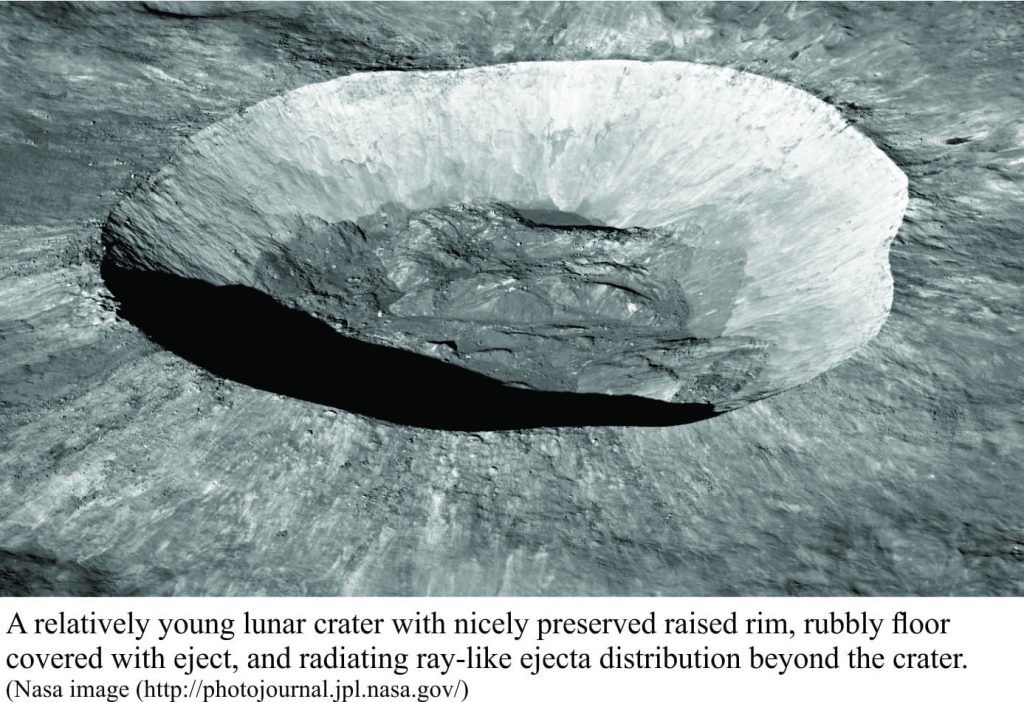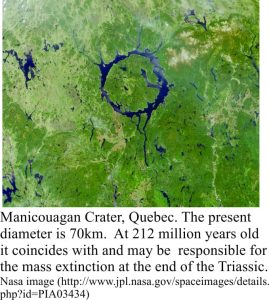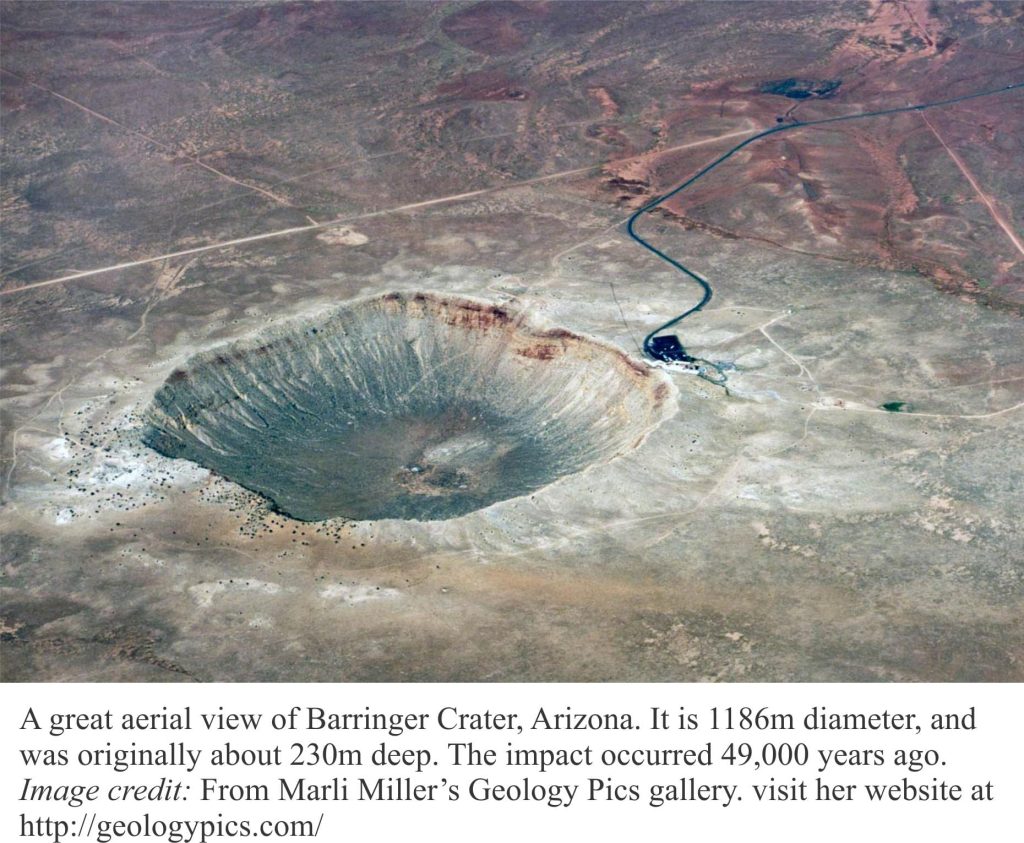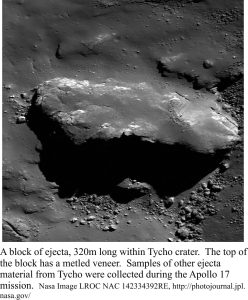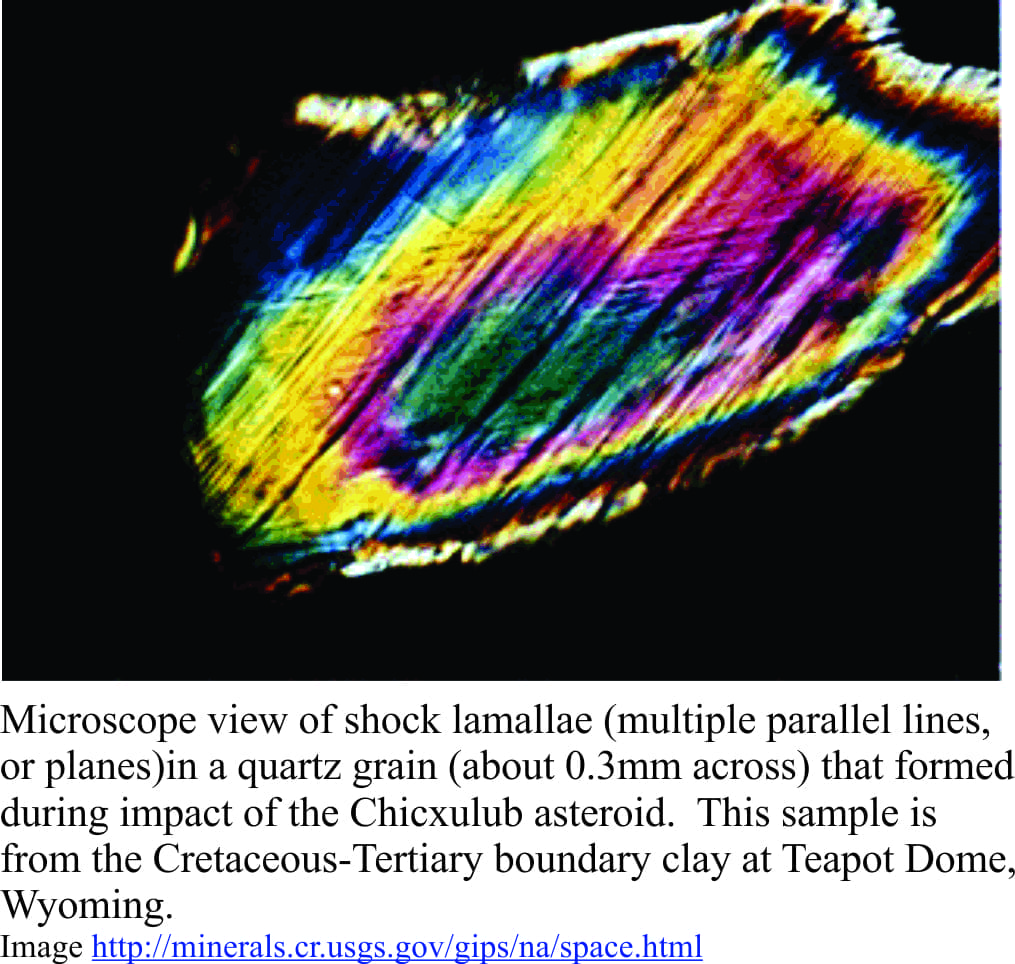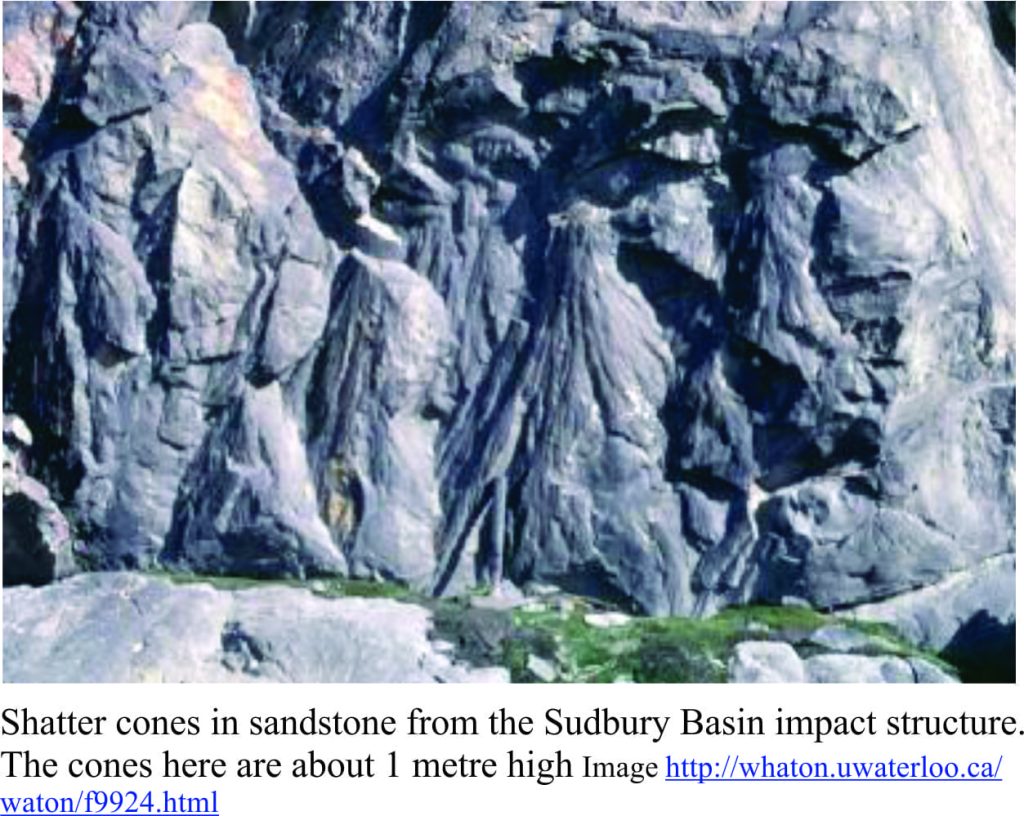The expression global extinction frequently conjures images of all life being snuffed out by an act of celestial hubris. Asteroids, bolides or comets can be lobbed our way at whim. Earth, in its first billion years or so was probably hammered by extra-terrestrial bits of rock and ice. The cratered surface of our moon attests to this. Some argue that it was these early collisions that provided at least some of our water and possibly even the organic compounds that eventually gave rise to life itself.
There is no doubt that earth has received its fair share of celestial flotsam and jetsam over its first 500 million years. Most of the evidence for this early bombardment has disappeared, consumed by the destruction and renewal of several generations of continental and oceanic plates. However, some evidence has survived. One of the oldest structures that still presents its crater outline is the 214 million year old Manicouagan Crater in Quebec.
The geologically recent and beautifully preserved Barringer Crater in Arizona is another great example (about 50,000 years ago).
If impacts took part in a popularity contest then the event 65 million years ago would win hands-down. The Chicxulub impact (north Yucatan Peninsula) coincides with the Cretaceous-Tertiary boundary (geological periods), also known as the K-T boundary. This event has been strongly implicated in the extinction of our favourite fossils, dinosaurs, although lots of other life forms disappeared as well – fortunately, not the mammals! We cannot actually see the impact crater at the surface. But several lines of evidence indicate its presence, evidence that helps us to identify other ancient impacts.
Changes to earth’s gravity
Earth’s gravity is determined by the density and distribution of rock and water; dense rocks, like those with lots of iron-rich minerals have a higher gravitational potential than less dense rocks. Large asteroid impacts will have a dramatic effect on the local gravity field because of the intense shattering, melting and ejection of rock. 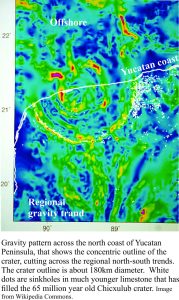
The Chicxulub Crater was discovered in the 1970s from gravity surveys and drilling during oil exploration. The image above shows concentric gravity patterns that outline a crater about 180 km in diameter, disrupting the regional north-south trending patterns. Drilling within this structure has since discovered shattered (brecciated) and melted rock that formed in the immediate aftermath of the impact. Thus, even though there is no visible sign of an impact crater at the surface, there may be a record of it deep in the earth’s crust.
Ejected material
Large asteroids are likely to blast a pretty big hole in the crust on impact, 100s or 1000s of metres deep. Rock and water will be ejected over large areas, even globally. Some materials will be vaporized, the resulting aerosols and dust being distributed widely through the atmosphere. Heat generated at impact will also partly melt the shattered bedrock. Many of the moon’s craters show signs of melting.
Glass is the common product of melting rock and subsequent rapid cooling; it is analogous to volcanic glass or obsidian. Globules of glass melt, or tektites a few millimetres in diameter can be cast far and wide; tektites from the Chicxulub impact are common in 65 million year old deposits in Haiti (about 1500km east) and as far afield as Wyoming 2500km north.
Shattered and brecciated rock can occur within the crater (as seen in many lunar structures), along the crater rim, and spread outward from the crater. This is sometimes referred to as fall-back breccia. Recent drilling into Chicxulub Crater has retrieved brecciated and partly melted bedrock and even, it seems, fragments of the original meteorite.
Shocking forces
There are unimaginable forces and heat generated by an impact like the Chicxulub asteroid, calculated to be about 10km in diameter; the immediate fireball incinerated everything within a several 100 km radius, dampened by massive tsunamis. Tell-tale structures that develop under these humungous stresses are found in crystals and rocks in the immediate vicinity of the impact (the only other force capable of generating these structures is a nuclear blast). Quartz crystals, that are common in many kinds of bedrock, develop a series of parallel laminae, called shock lamellae. The lamellae indicate deformation, or breakage of the crystal along multiple, parallel planes. Shocked quartz, once formed can also be scattered widely with the other ejecta.
Shatter cones, another distinctive structure, form in thicker rock. They commonly are seen as overlapping 3-dimensional cones, pointy end up. The examples shown here, from the 1850 million year Sudbury Impact structure (Ontario, Canada) are about a metre high. Shatter cones have been found at several other impact sites, along with shocked quartz, and melt breccias.
Chemical fingerprints
Although meteorites contain all the elements found in earth materials, some element groups are present in much different proportions. One example is the Platinum Group that contains Ruthenium, Rhodium, Palladium, Osmium, Iridium (Ir) and Platinum; these elements are rare in most earth rocks. In 1980, Walter and Luis Alvarez discovered, in a clay layer (a few millimetres thick) at the Cretaceous-Tertiary boundary in Italy, that the Iridium (Ir) concentration was about 500 parts per billion (ppb). Background levels in earth rocks are about 0.1-0.3 ppb. The Ir anomaly, as it is now known, is more than 100 times higher than expected, but is similar to the concentrations found in meteorites. The Alvarez’ concluded that the Ir spike was caused by fallout from an asteroid impact. Iridium anomalies have now been found in many clay deposits around the world, in strata that occur at the K-T boundary. The culprit in this case was the Chicxulub event.
The scenario envisaged is thus: on impact the meteorite (asteroid) is fragmented and vapourised. Aerosols and dust that contain Iridium are widely distributed in the upper and lower atmosphere. Fallout, probably over several years, leads to accumulation with clay deposits (this would tend to take place on lake beds and sea floors where there were no strong currents).
Postscript
In science, the rigorous testing of hypotheses is paramount. Hypotheses that are supported are developed further, those that are not are put aside. Hypotheses that deal with asteroid impacts also deserve objective, rigorous testing. The real problem for science and humanity is that an earthly test of the impact ideas may well wipe us off the map. Is this a matter of celestial dice or Divine intervention? Perhaps a Mark Twain comment serves best here; “I guess so, I dunno…“.
Links to a few impact sites
Chicxulub Crater, Yucatan
Vredefort Dome, South Africa (this is a UNESCO World Heritage Site
Sudbury Basin, Ontario
Manicouagan Lake, Quebec
Beaverhead Crater, Montana-Idaho
Gosse’s Bluff, Australia
Clearwater Lakes, Quebec
Addendum
John Lang, via the OilPro.com media site pointed me in the direction of this cool video on the cenotes, or sinkholes that have formed in the younger limestone and marl deposits that filled the crater. The semicircular alignment of cenotes coincides with the landward Chicxulub crater margin as it is outlined in the gravity map (above). Clearly, the deeply buried Chicxulub crater has some structural influence over groundwater flow and formation of the cenotes and cave systems in the limestones.
